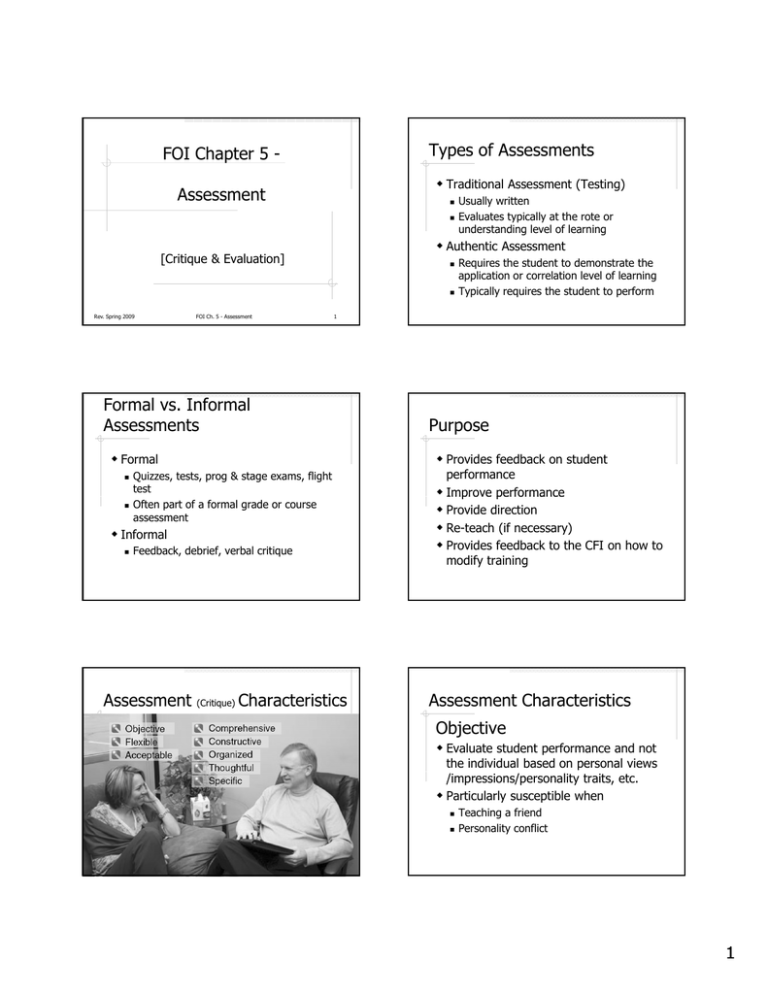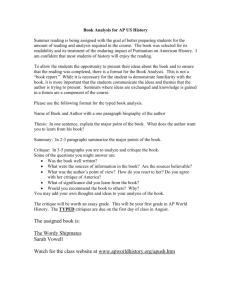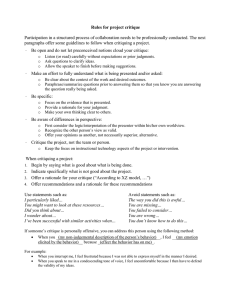Types of Assessments FOI Chapter 5 - Assessment
advertisement

Types of Assessments FOI Chapter 5 - Traditional Assessment (Testing) Assessment Authentic Assessment [Critique & Evaluation] Rev. Spring 2009 FOI Ch. 5 - Assessment Formal Feedback, debrief, verbal critique Assessment Purpose Provides feedback on student Quizzes, tests, prog & stage exams, flight test Often part of a formal grade or course assessment Informal Requires the student to demonstrate the application or correlation level of learning Typically requires the student to perform 1 Formal vs. Informal Assessments Usually written Evaluates typically yp y at the rote or understanding level of learning (Critique) Characteristics performance Improve performance Provide direction Re-teach (if necessary) Provides feedback to the CFI on how to modify training Assessment Characteristics Objective Evaluate student performance and not the individual based on personal views /impressions/personality traits, etc. Particularly susceptible when Teaching a friend Personality conflict 1 Assessment Characteristics Assessment Characteristics Flexible Acceptable Must fit the tone, technique and The student must accept the instructor content of the assessment to the occasion Assessment Characteristics as someone worthy of giving the critique The student must have confidence in the instructor The instructor must be fair and sincere Assessment Characteristics Comprehensive Constructive Include both strengths and weaknesses Point out strengths and identify The CFI needs to figure out the balance between these two Watch out for trying to be too long where/why they were good Point out weaknesses and give direction for improvement Assessment Characteristics Encourage potential Assessment Characteristics Well Organized Thoughtful Good then bad / Bad then good Progress g of flight g Progress of records Must remember that the student is an individual Recognize need for self esteem, recognition and approval Must respect the student's personal feelings The CFI still needs to be straightforward and honest 2 Assessment Characteristics Specific Be specific both in identifying strengths and weaknesses Back up observations & comments with details Students should leave with clear understanding of What was good / What was bad How to improve Types of Quizzing / Testing / Assessment Oral Written Performance (Practical) Types of Assessments Traditional Assessment (Testing) Usually written Evaluates typically yp y at the rote or understanding level of learning Authentic Assessment Requires the student to demonstrate the application or correlation level of learning Typically requires the student to perform Testing at the appropriate level Traditional Authentic Traditional Assessments Rote - Who, What, When, Where Understanding - How, Why, Explain Traditional how, Explain why Application - Give scenario Authentic Correlation - Types of written questions Supply type Fill in Short answer Essay Selection type True/False Multiple choice Matching 3 Characteristics of good questions Has one correct answer Single thought - Question should focus on level of learning Emphasize the negative Avoid ambiguous statements Characteristics of good written questions Proper stems Clearly presented thought Present material that is relevant Does not give away the answer Gives all the material - avoid repetitious answers Equal length alternatives Proper grammar Characteristics of good tests More Info in Appendix B Reliable - Should provide consistent results Valid - Measures what it is supposed to measure Usable - You are testing the student's knowledge of a particular topic, topic not the ability to take the test Objective - should be able to be objectively scored Comprehensive - Should cover all aspects of area to be covered Discrimination - Should differentiate small differences in achievement Authentic Assessments Collaborative Assessment Student Centered Grading Replay – Have the student replay the activity Reconstruct – Have the student assess what should have been done differently Reflect – Have the student “reflect” on what he/she has learned (learning journal) Redirect – Evaluate how the learning might affect other lessons 4 Performance “Grades” Maneuver “Grades” Describe Explain Practice Perform (Not Observed) SRM “Grades” Explain Practice Mange - Decide Types of Critiques Instructor / Student Critique Student Led Critique Small Group Critique Individual Student Critique by Another Student Self Critique Written – Oral – Combined Common misconceptions The critique is not a step in the grading process.. It is a step in the learning process The critique does not necessarily need to be negative in context Critiques and Oral Assessments Oral Assessment... Reveals effectiveness of the instructor’s training Checks the students comprehension & retention t ti It reviews & emphasizes the important points of training. It identifies points which need more emphasis. It promotes active student participation Conducting the Critique When - immediately How long - generally 20 min. maximum unless re re-teaching teaching 5 Ground rules for critiquing Keep it brief & on time Avoid trying to cover too much. Allow time for a summary Avoid dogmatic or absolute statements Ground rules for critiquing... Avoid controversies with the class Never allow yourself to be maneuvered into the unpleasant position of defending criticism If part of the critique is written, make certain that it is consistent with the oral Questions to Avoid Puzzle Oversize Toss Toss-Up Up Bewilderment Trick Irrelevant 6



